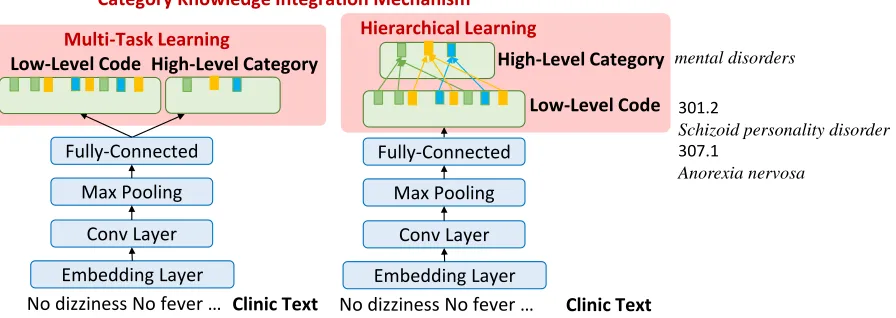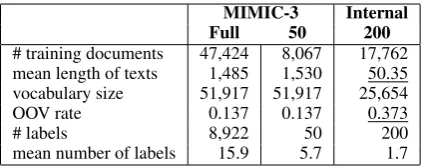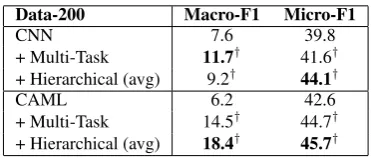Proceedings of the 10th International Workshop on Health Text Mining and Information Analysis (LOUHI 2019), pages 39–43 39
Leveraging Hierarchical Category Knowledge for
Data-Imbalanced Multi-Label Diagnostic Text Understanding
Shang-Chi Tsai Ting-Yun Chang Yun-Nung Chen
Department of Computer Science and Information Engineering National Taiwan University, Taipei, Taiwan
{r06946004,r06922168}@ntu.edu.tw y.v.chen@ieee.org
Abstract
Clinical notes are essential medical documents to record each patient’s symptoms. Each record is typically annotated with medical di-agnostic codes, which means diagnosis and treatment. This paper focuses on predicting diagnostic codes given the descriptive present illness in electronic health records by leverag-ing domain knowledge. We investigate vari-ous losses in a convolutional model to utilize hierarchical category knowledge of diagnostic codes in order to allow the model to share se-mantics across different labels under the same category. The proposed model not only con-siders the external domain knowledge but also addresses the issue about data imbalance. The MIMIC3 benchmark experiments show that the proposed methods can effectively utilize category knowledge and provide informative cues to improve the performance in terms of the top-ranked diagnostic codes which is bet-ter than the prior state-of-the-art. The investi-gation and discussion express the potential of integrating the domain knowledge in the cur-rent machine learning based models and guid-ing future research directions.
1 Introduction
Electronic health records (EHR) usually contain clinical notes, which are free-form text gener-ated by clinicians during patient encounters, and a set of metadata diagnosis codes from the Inter-national Classification of Diseases (ICD), which represent the diagnoses and procedures in a stan-dard way. ICD codes have a variety of usage, rang-ing from billrang-ing to predictive modelrang-ing of the pa-tient state (Choi et al.,2016). Automatic diagnosis prediction has been studied since 1998 (de Lima et al.,1998).Mullenbach et al.(2018) pointed out the main challenges of this task: 1) the large label space, with over 15,000 codes in the ICD-9 taxon-omy, and over 140,000 codes in the newer
ICD-10 taxonomies (Organization et al.,2007), and 2) noisy text, including irrelevant information, mis-spellings and non-standard abbreviations, and a large medical vocabulary. Several recent work at-tempted at solving this task by neural models (Shi et al.,2017;Mullenbach et al.,2018).
However, most prior work considered the out-put labels independently, so that the codes with few samples are difficult to learn (Shi et al.,2017). Therefore,Mullenbach et al. (2018) proposed an attentional model to effectively utilize the textural forms of codes to facilitate learning. In addition to textual definitions of codes, thecategorydomain knowledge may provide additional cues to allow the codes under same category to share parame-ters, so the codes with few samples can benefit from it. To effectively utilize thecategory knowl-edgefrom the ICD codes, this paper proposes sev-eral refined category losses and incorporate them into convolutional models and then evaluate the performance on both MIMIC-3 (Johnson et al., 2016) and our internal dataset. The experiments on MIMIC shows that the proposed knowledge in-tegration model significantly improves the previ-ous methods and achieves the state-of-the-art per-formance, and the improvement can also be ob-served in our internal dataset. The idea is similar to the prior work (Singh et al.,2018), which con-sidered the keyword hierarchy for information ex-traction from medical documents, but our work fo-cuses on leveraging domain knowledge for clinical code prediction. Our contributions are three-fold:
• This paper first leverages external domain knowledge for diagnostic text understanding.
• The paper investigates multiple ways for in-corporating the domain knowledge in an end-to-end manner.
Multi-Task Learning
High-Level Category
Clinic Text No dizziness No fever …
Conv Layer Max Pooling Fully-Connected
Embedding Layer Low-Level Code
Hierarchical Learning
Low-Level Code High-Level Category Category Knowledge Integration Mechanism
Clinic Text No dizziness No fever …
Conv Layer Max Pooling Fully-Connected
Embedding Layer
301.2
Schizoid personality disorder
307.1
[image:2.595.79.527.73.232.2]Anorexia nervosa mental disorders
Figure 1: The architecture with the proposed category knowledge integration.
models and achieves the state-of-the-art per-formance on the benchmark MIMIC dataset.
2 Methodologies
Given each clinical record in EHR, the goal is to predict the corresponding diagnostic codes with the external hierarchical category informa-tion. This task is framed as a multi-label classifi-cation problem. The proposed mechanism is built on the top of various convolutional models to fur-ther combine with the category knowledge. Be-low we introduce the previously proposed convo-lutional models which are used for latter compar-ison in the experiment and detail the mechanism that leverages hierarchical knowledge.
2.1 Convolutional Models
There are various models for sequence-level clas-sification, and this paper focuses on two types of convolutional models for investigation. The mod-els are described as follows. Note that the pro-posed mechanism is flexible for diverse models.
TextCNN Let xi ∈ IRk be the k-dimensional word embedding corresponding to the i-th word in the document, represented by the matrixX = [x1, x2, ..., xN], whereN is the length of the doc-ument. TextCNN (Kim,2014) applies both convo-lution and max-pooling operations in one dimen-sion along the document length. For instance, a feature ci is generated from a window of words
xi, xi+1, ..., xi+h, where h is the kernel size of the filters. The pooling operation is then applied overc= [c1, c2, ..., cn−h+1]to pick the maximum valuecˆ= max(c)as the feature corresponding to this filter. We implement the model with kernel
size = 3,4,5, considering different window sizes of words.
Convolutional Attention Model (CAML) Be-cause the number of samples of each code is highly unbalanced, it is difficult to train each la-bel with very few samples. To resolve this issue, the CAML model utilizes the descriptive defini-tion of diagnosis codes, which addidefini-tionally applies a per-label attention mechanism, where the addi-tional benefit is that it selects the n-grams from the text that are most relevant to each predicted la-bel (Mullenbach et al.,2018).
2.2 Knowledge Integration Mechanism
Considering the hierarchical property of ICD codes, we assume that using the higher level la-bels could learn more general concepts and thus improve the performance. For instance, the def-initions of ICD-9 codes 301.2 and 307.1 are “Schizoid personality disorder” and “Anorexia nervosa” respectively. If we only use the labels given by the dataset, they are seen as two indepen-dent labels; however, in the ICD structure, both 301.2and307.1belong to the same high-level cat-egory “mental disorders”. The external knowl-edge shows that category knowlknowl-edge provides ad-ditional cues to know code relatedness. Therefore, we propose four types of mechanisms that incor-porate hierarchy category knowledge to improve the ICD prediction below.
mean of all ICD codes and the mean of each cate-gory.
Ωbetween= K X
k=1
θ¯k−θ¯
2
, (1)
whereθ¯is the mean vectors of all ICD codes,θ¯kis the mean vector of thek-th category. The within-cluster constraint, Ωwithin, is the distance of pa-rameters between the mean of each category and its low-level codes.
Ωwithin= K X
k=1
X
i∈J(k)
θi−θ¯k
2
, (2)
whereJ(k)is a set of labels that belong to thek -th category. Ωbetween andΩwithin are formulated as additional losses to enable the model to share parameters across codes with the same categories.
Multi-Task Learning Considering that the high-level category can be treated as another task, we apply a multi-task learning approach to leverage the external knowledge. This model focuses on predicting the low-level codes,ylow, as well as its high-level category,yhigh, individually illustrated in Figure1.
yhigh=Whigh·h+bhigh (3)
whereWhigh ∈IRNhigh×d,Nhighmeans the num-ber of high-level categories, anddis the dimension of hidden vectors derived from CNN.
Hierarchical Learning We build a dictionary for mapping our low-level labels to the corre-sponding high-level categories illustrated in Fig-ure1. To estimate the weights for high-level cate-gories,yhigh, two mechanisms are proposed:
• Average meta-label: The probability of thek -th high-level category can be approximated by theaveraged weights for low-level codes that belong to thek-th category.
yhigh = 1 k
X
yklow (4)
• At-least-one meta-label: Motivated by Nie et al. (2018), meta labels are created by ex-amining whether any disease label for thek -th category has been marked as tagged, where the high-level probability is derived from the low-level probability of disease labels.
yhigh = 1− Y
k
(1−yklow) (5)
MIMIC-3 Internal Full 50 200
# training documents 47,424 8,067 17,762 mean length of texts 1,485 1,530 50.35 vocabulary size 51,917 51,917 25,654
OOV rate 0.137 0.137 0.373
# labels 8,922 50 200
[image:3.595.311.522.61.145.2]mean number of labels 15.9 5.7 1.7
Table 1: Dataset comparison and statistics. From the full set of the internal data (1495 labels) to 200, only 6.0% of data points are discarded.
2.3 Training
The knowledge integration mechanisms are built on top of the multi-label convolutional models, which treat each ICD label as a binary classifi-cation. The predicted values for high-level cate-gories come from the proposed mechanisms. Con-sidering that learning low-level labels directly is difficult due to the highly imbalanced label dis-tribution, we add a loss term indicating the high-level category in order to learn the general con-cepts in addition to the low-level labels, and train the model in an end-to-end fashion. Note that the high-level loss is set as losshigh = Ωbetween + Ωwithinfor cluster penalty and the binary log loss for other methods.
loss=losslow+λ·losshigh, (6)
whereλis the parameter to control the influence of the knowledge category and we chooseλ= 0.1.
3 Experiments
In order to measure the effectiveness of the pro-posed methods, the following experiments are conducted.
3.1 Setup
MIMIC3-50 P@1 P@3 P@5 MAP Macro-F Micro-F Macro-AUC Micro-AUC
CNN (Shi et al.,2017) 82.8 71.2 61.4 72.4 57.9 63.0 88.2 91.2
+ Cluster Penalty 83.5† 71.9† 62.4† 73.1† 58.3† 63.7† 88.5† 91.3†
+ Multi-Task 83.5† 71.3† 61.9† 72.5† 57.6 62.8 88.1 91.1
+ Hierarchical avg 84.5† 72.1† 62.4† 73.5† 58.6† 64.3† 88.9† 91.4†
at-least-one 83.4† 72.1† 62.4† 73.4† 58.5† 63.8† 88.4† 91.3†
MIMIC3-Full P@1 P@3 P@8 P@15 Macro-F Micro-F Macro-AUC Micro-AUC
CNN (Shi et al.,2017) 80.5 73.6 59.6 45.4 3.8 42.9 81.8 97.1
+ Cluster Penalty 80.9† 74.0† 59.5 45.2 3.3 40.5 82.1† 97.0
+ Multi-Task 82.8† 75.8† 61.5† 46.6† 3.6 43.9† 83.3† 97.3†
+ Hierarchical avg 79.0 73.1 59.2 45.2 4.3† 42.7 83.0† 97.1
at-least-one 82.1† 74.3† 59.7† 44.9 2.6 42.0 80.3 96.7
CAML (Mullenbach et al.,2018) 89.6 83.4 69.5 54.6 6.1 51.7 88.4 98.4
+ Cluster Penalty 88.4 82.4 68.8 54.0 5.4 51.2 87.5 98.3
+ Multi-Task 89.7† 83.4 69.7† 54.8 6.9† 52.3† 88.8† 98.5†
+ Hierarchical avg 89.6 83.5† 70.9† 56.1† 8.2† 53.9† 89.5† 98.6†
[image:4.595.73.538.61.248.2]at-least-one 89.4 83.3 69.5 54.8† 6.2† 51.7 88.3 98.4
Table 2: The results on MIMIC-3 data (%). †indicates the improvement over the baseline.
Data-200 Macro-F1 Micro-F1
CNN 7.6 39.8
+ Multi-Task 11.7† 41.6†
+ Hierarchical (avg) 9.2† 44.1†
CAML 6.2 42.6
+ Multi-Task 14.5† 44.7†
+ Hierarchical (avg) 18.4† 45.7†
Table 3: The results on NTUH data.
from an internal hospital, where each record in-cludes narrative notes describing a patients stay and associated diagnostic ICD-9 codes. There are total 1,495 ICD-9 codes in the data, and the dis-tribution is highly imbalanced. Our data is noisy due to typos and different writing styles, where the OOV rate is 0.373 based on the large vocab-ulary obtained from PubMed and PMC. As shown in Table 1, our data, Internal-200, is more chal-lenging due to much shorter text inputs and higher OOV rate compared with the benchmark MIMIC-3 dataset. We split the whole set of 25,MIMIC-375 records from Internal-200 into 17,762 as training, 2,537 as validation, and 5,076 as testing.
All models use the same setting as the prior work (Kim, 2014; Mullenbach et al., 2018) and use skipgram word embeddings trained on PubMed1 and PMC2 (Mikolov et al., 2013). We evaluate the model performance using metrics for the multi-label classification task, including pre-cision at K, mean average precision (MAP), and micro-averaged, macro-averaged F1 and AUC.
1
https://www.ncbi.nlm.nih.gov/pubmed/
2https://www.ncbi.nlm.nih.gov/pmc/
3.2 Results
The baseline and the results of adding the pro-posed mechanisms are shown in Table 2. For MIMIC3-50, all proposed mechanisms achieve the improvement for almost all metrics, and the best one is from the hierarchical learning with aver-age meta-label. The consistent improvement indi-cates that category knowledge provides informa-tive cues for sharing parameters across low-level codes under the same categories. For MIMIC3-Full, our proposed mechanisms still outperform the baseline CNN model, and the best perfor-mance comes from the one with multi-task learn-ing. The reason may be that multi-task learn-ing has more flexible constraints compared with hierarchical learning, and it is more suitable for this more challenging scenario due to data imbal-ance. In addition, the proposed knowledge inte-gration mechanisms using multi-task learning or hierarchical learning with average meta-label are able to improve the prior state-of-the-art model, CAML (Mullenbach et al.,2018), demonstrating the superior capability and the importance of do-main knowledge.
[image:4.595.88.274.291.370.2]capable of improving the text understanding per-formance by combining the domain knowledge with neural models and achieve the state-of-the-art results.
3.3 Qualitative Analysis
From our prediction results, we find that our pro-posed mechanisms tend to predict more labels than the baseline models for both CNN and CAML. Specifically, our methods can assist models to con-sider more categories from shared information in the hierarchy. The additional codes often contain the right answers and sometimes are in the correct categories but not exactly matched. Moreover, our mechanisms have the capability of correcting the wrong codes to the correct ones which are under the same category. The appendix provides some examples for reference.
4 Conclusion
This paper proposes multiple mechanisms using the refined losses to leverage hierarchical category knowledge and share semantics of the labels under the same category, so the model can better under-stand the clinical texts even if the training sam-ples are limited. The experiments demonstrate the effectiveness of the proposed knowledge integra-tion mechanisms given the achieved state-of-the-art performance and show the great generalization capability for multiple datasets. In the future, we plan to analyze the performance of each label, in-vestigating which label can benefit more from the proposed approaches.
Acknowledgements
We would like to thank reviewers for their insight-ful comments on the paper. This work was finan-cially supported from the Young Scholar Fellow-ship Program by Ministry of Science and Technol-ogy (MOST) in Taiwan, under Grant 108-2636-E002-003 and 108-2634-F-002-015.
References
Edward Choi, Mohammad Taha Bahadori, Andy Schuetz, Walter F Stewart, and Jimeng Sun. 2016. Doctor ai: Predicting clinical events via recurrent neural networks. InMachine Learning for Health-care Conference, pages 301–318.
Alistair EW Johnson, Tom J Pollard, Lu Shen, H Lehman Li-wei, Mengling Feng, Moham-mad Ghassemi, Benjamin Moody, Peter Szolovits,
Leo Anthony Celi, and Roger G Mark. 2016. Mimic-iii, a freely accessible critical care database.
Scientific data, 3:160035.
Yoon Kim. 2014. Convolutional neural networks for sentence classification. InProceedings of the 2014 Conference on Empirical Methods in Natural Lan-guage Processing (EMNLP), pages 1746–1751.
Luciano RS de Lima, Alberto HF Laender, and Berthier A Ribeiro-Neto. 1998. A hierarchical ap-proach to the automatic categorization of medical documents. In Proceedings of the seventh inter-national conference on Information and knowledge management, pages 132–139. ACM.
Tomas Mikolov, Ilya Sutskever, Kai Chen, Greg S Cor-rado, and Jeff Dean. 2013. Distributed representa-tions of words and phrases and their compositional-ity. InAdvances in neural information processing systems, pages 3111–3119.
James Mullenbach, Sarah Wiegreffe, Jon Duke, Jimeng Sun, and Jacob Eisenstein. 2018. Explainable pre-diction of medical codes from clinical text. In Pro-ceedings of the 2018 Conference of the North Amer-ican Chapter of the Association for Computational Linguistics: Human Language Technologies, vol-ume 1, pages 1101–1111.
Allen Nie, Ashley Zehnder, Rodney L Page, Arturo L Pineda, Manuel A Rivas, Carlos D Bustamante, and James Zou. 2018. Deeptag: inferring all-cause diag-noses from clinical notes in under-resourced medical domain.arXiv preprint arXiv:1806.10722.
World Health Organization et al. 2007. In-ternational statistical classification of dis-eases and related health problems: tenth revision-version for 2007. http://apps. who. int/classifications/apps/icd/icd10online/.
Haoran Shi, Pengtao Xie, Zhiting Hu, Ming Zhang, and Eric P Xing. 2017. Towards automated icd coding using deep learning. arXiv preprint arXiv:1711.04075.


